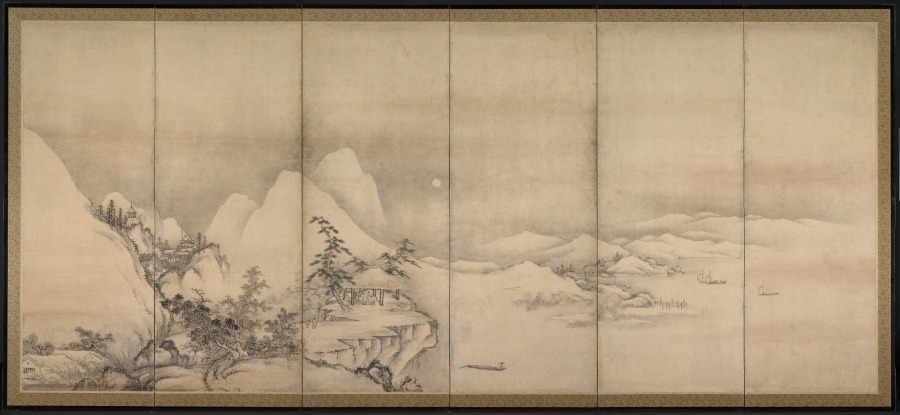| schema:description 10 | "id: 140324" |
| schema:description | "measurements: Image: 155.5 x 357.8 cm (61 1/4 x 140 7/8 in.); Overall: 171.5 x 373.4 cm (67 1/2 x 147 in.); Closed: 171.5 x 63.5 x 11 cm (67 1/2 x 25 x 4 5/16 in.)...(more)" |
| schema:description | "culture: Japan, Muromachi period (1392-1573)" |
| schema:description | "tombstone: Chinese Landscape, 1500s. Japan, Muromachi period (1392-1573). One of a pair of six-fold screens; ink and slight color on paper; image: 155.5 x 357.8 cm (61 1/4 x 140 7/8 in.); overall: 171.5 x 373.4 cm (67 1/2 x 147 in.); closed: 171.5 x 63.5 x 11 cm (67 1/2 x 25 x 4 5/16 in.). The Cleveland Museum of Art, Severance and Greta Millikin Collection 1964.279.2...(more)" |
| schema:description | "collection: ASIAN - Folding screen" |
| schema:description | "digital_description: In a panorama of mountains and expanses of water, three gentlemen have assembled by moonlight to enjoy one another’s company away from a bustling village. An influx of ink paintings from China in both album and scroll formats beginning in the late 1200s inspired Japanese artists to create landscapes based upon Chinese prototypes. Later, Japanese painters adapted the imagery to the larger format of folding screens, which were used to define spaces in large rooms....(more)" |
| schema:description | "creditline: Severance and Greta Millikin Collection" |
| schema:description | "wall_description: This <em>byōbu </em>(folding screen) and its pair bears neither signature or seals that reveal its authorship. Many such paintings were executed in Japan in the 16th century painting studios that provided these works on commission for the country’s upperclass patrons. Paintings were ordered according to subject matter, preferred painting style, format, size, and materials. As is evident here, paper rather than silk or gold predominated as the ground for the painted imagery. Because of their size, byōbu cost more than hanging scrolls, albums, or handscrolls. The talents of skilled carpenters, metalwork and lacquer craftsmen, and mounting preparators were coordinated to provide the folding screen structure to which the painting was adhered. These byōbu served as part of the interior furnishings of a Japanese residence, temple, or government building. There they functioned as interior decor, space dividers, props for secular or religious ceremonies, or even as attractive maps of famous sites, both imagined and real. Here an imaginary Chinese landscape of towering mountain peaks, vast expanses of water, and deep, distant panoramas includes many activities, an assortment of buildings and seasonal and temporal references....(more)" |
| schema:description | "technique: One of a pair of six-fold screens; ink and slight color on paper" |
| schema:description | "type: Painting" |

